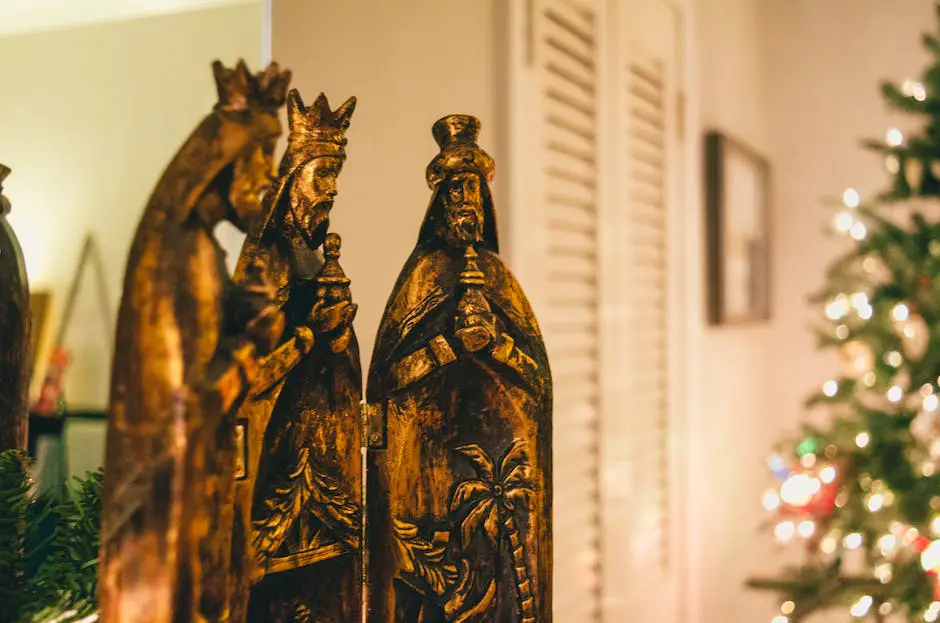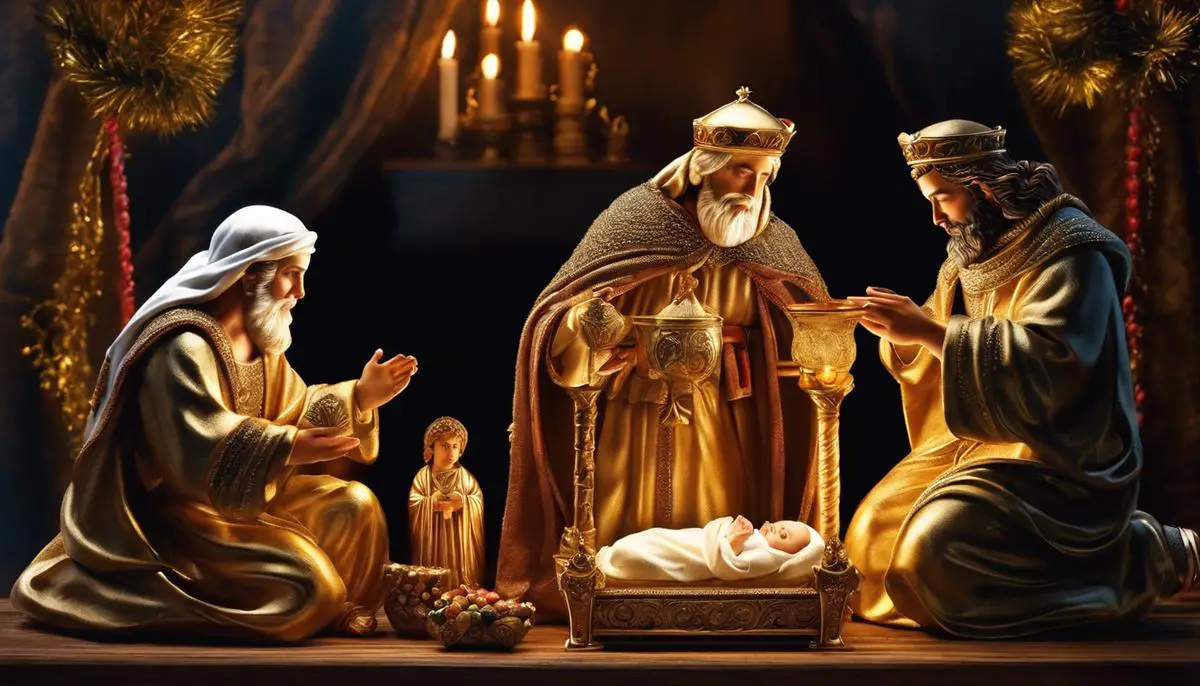
The three wise men, often referred to as the Magi or Kings, hold a profound significance in the Christian narrative as celestial scholars who embarked on a divinely guided journey to honor the birth of Jesus Christ.
Chiseled within biblical accounts, their story unveils faith, revelations, and symbolic gifts, emphasizing Jesus’ divine origin and mission on Earth.
Shrouded in mystery, their historical context, from origins to societal status, offers intriguing insights into the genesis of Christianity.

The Historical Context of the Three Wise Men
Have you ever been captivated by the mesmerizing story of the Three Wise Men in the Gospel of Matthew?
Homage to newborn Savior, Jesus Christ, is a fundamental Christian narrative, underscoring the divine magnitude of His birth.
Often referred to as the Magi, the Three Wise Men bear tangible echoes of an era cloaked in mystery and historical intrigue.
Their story is mysterious and brief – but it’s also one of the most poignant accounts in biblical literature.
These men hailed from the East.

Though not explicitly outlined in Scriptures, biblical scholars generally agree the Three Wise Men likely hailed from ancient Persia, modern-day Iran.
The term ‘Magi‘ itself is an ancient Persian term for a segment of the priestly caste, which further reinforces the likelihood of this origin.
Many assume the Wise Men to be kings due to the valuable gifts they bore.
The three gifts: gold, frankincense, and myrrh, each have symbolic significance.
Gold is a symbol of kingship, frankincense a symbol of priesthood, and myrrh, often used in embalming, is a symbol of death.
These symbols interestingly foretell of Jesus’s role as king, priest, and the sacrificial lamb.
As they journeyed to Palestine, the Three Wise Men occupied a pivotal moment in history – the first century AD.
This period, also known as the Pax Romana, was a time of relative peace and minimal expansion by military force under Roman rule.
The necessity for the Wise Men to journey to Jerusalem to discern the location of this King indicates they were most likely knowledgeable intellectuals adept in astrology and probably other monotheistic faiths.
Celestial Guidance of the Magi

By focusing on the star “in the east,” we can glean a deeper understanding of why these men set off on their daunting journey.
By ancient traditions, heavenly bodies were believed to announce significant births or deaths.
So, with their understanding of astrology, the Magi interpreted this particular celestial body as the announcement of the birth of a king – the King of the Jews.
Their intent visit and their valuable gifts to baby Jesus encapsulate their reverence and acknowledgment of this unique Child’s vital role in this world.
Their visit indicates the widespread reach of Jesus’s divine identity and purpose, transcending geographical, cultural, and religious barriers.
The story of the Three Wise Men reminds us of a deep, universal truth- that he who seeks shall find.
The Magi, though they were Gentiles, sought the King of Jews sincerely and found Him.
In much the same way, let’s remember that we, regardless of our backgrounds or experiences, can seek Jesus earnestly with the certainty that we will indeed find Him.
Symbolic Significance of the Three Wise Men

Every detail in the Gospel, no matter how small or seemingly mundane, is laden with significance.
In Matthew 2:11, we are told about the adoration of Jesus by the Magi, often referred to as the Three Wise Men.
We learn they offered three distinct gifts- gold, frankincense, and myrrh- to the newborn King.
While it is evident that these men presented Jesus with gifts of great value, many might be unaware of the deeper, symbolic significance these offerings hold.
Gold, a precious metal universally recognized for its worth, is traditionally associated with kings and royalty.
This valuable material was not just a gift of wealth but was a symbol of Jesus’s kingship here on earth.
It was an early acknowledgment of Jesus as the “King of the Jews,” an affirmation that was later echoed by the inscription on the cross during His crucifixion.
Frankincense, a white resin or gum, is extracted from a tree by slashing the bark and allowing the exuded resins to bleed out and harden.
It has been used throughout history in worship where it is burned as a fragrant offering before God.
The gift of frankincense signified Jesus’s divine nature, His priesthood, and His role as an intermediary between God and humanity.
It underscored His mission to bridge the divide between a holy God and sinful mankind.
Myrrh’s Prophetic Significance: Jesus’ Suffering, Death, and Resurrection

Lastly, the Wise Men also brought myrrh, a perfume used for embalming the bodies of the dead.
This gift carries an almost prophetic significance as it foretold Jesus’s suffering, death, and ensuing resurrection.
Myrrh served as a somber foreshadowing or precursor to the sacrifice Jesus would later make on the cross, offering redemption and eternal life to humankind.
These three gifts echo the truth that every aspect of the life of Jesus was filled with significance, from His humble birth to His victorious resurrection.
They speak loudly about who Jesus is – the King of Kings, the perfect High Priest, and the sacrificial Lamb of God.
The understanding of these symbolic gifts can enhance our comprehension of the gospel story itself, and deepen our gratitude for the unparalleled love, sacrifice, and authority of Jesus Christ.
It also serves as a reminder that our own offering to God does not go unnoticed, but holds profound significance in His divine plan.
The Three Wise Men’s Journey and Revelation

Their odyssey was not merely a quest to witness the newborn King, but it was an extraordinary pilgrimage of transformation driven by unwavering allegiance and prophetic foresight.
Amidst the inclement weather conditions, inhospitable terrains, and the potential hazards of a journey during the first century AD, there was an inexplicable force propelling the Magi towards their holy mission.
They were guided not by the certainty of a comprehensible map but by the celestial navigation of a divine star.
The account of this journey underscores the vital essence of having faith even when one cannot see the complete blueprint of God’s unique plan.
Evidently, the story of their quest strikes a profound chord because it narrates not just the physical journey undertaken by the Magi but also their spiritual evolution.
The exertions of their arduous journey were eclipsed by the divine revelations and spiritual transformations that they experienced.
Embarking on an uncertain path led by divine guidance, they were bestowed with the highest honor of being the first to recognize and adore the Savior of the world.
Upon their encounter with the infant Jesus, the Magi offered gifts, not out of obligation but rather a deep reverence for what lay ahead in Christ’s destiny.
The gift-giving is an integral part of the story as it underscores the prophecy of the life of Jesus and the salvation He would offer mankind.
The Wise Men did not just deliver tangible gifts; they also brought forth their spiritual gifts of faith, obedience, and perseverance.
The Wise Men’s Model of Worship and Adoration

Essentially, they model the concept of worship and adoration, demonstrating the ultimate expression of faithfulness and dedication to God’s word and plan.
Unraveling the tale of the Three Wise Men also reveals the divine insights and greatness that God bestows upon those who diligently seek Him.
The star that they followed was not simply a bright celestial body but a beacon that guided them to transformative spiritual truth and a deeper understanding of God’s redeeming love.
Indeed, this iconic biblical episode reminds us all to remain steadfast in our spiritual journeys, even amid life’s challenges and uncertainties.
Like the Wise Men, we embark on journeys guided by divine light and God’s promise, embracing spiritual quests with faith.
The saga of the Three Wise Men elucidates God’s grand design, where every journey, every gift, and every revelation has an ordained purpose.
It’s a potent reminder that God has a glorious plan for each one of us, just as He did for the Three Wise Men and for His precious Son, Jesus Christ.
Their journey embodies obedience, faith, and reverence—resonating across centuries, inspiring countless hearts in their walk with Christ.
Reflection of The Wise Men in Christian Culture and Traditions

In Christian culture and art, the enduring presence of the Three Wise Men vividly reminds us of dedication and reverence for Jesus’ birth.
This idea is notably reflected in Christian festivities, particularly during the Christmas season.
The January 6 Feast of the Epiphany marks the visit of the Three Wise Men to baby Jesus.
This celebration marks Jesus’ manifestation to the gentiles and honors the Wise Men’s perseverance in their spiritual quest.
This annual observance reminds us of faith, perseverance, and joy in discovering Christ, echoing the Wise Men’s experience.
These three figures have also found notable representation in nativity scenes, constantly reminding us of the determination and faith they exhibited during their journey.
Three men on camels, following a star, is a recurring image in Christian art and global symbolism.
Iconic renderings remind us of the Wise Men’s journey, inspiring faith and determination in our spiritual endeavors.
Christian hymns and songs often depict the journey of the Wise Men as a beacon of light and inspiration.
The popular Christmas carol, “We Three Kings,” embodies their spiritual voyage, the struggles they endured, and the joy of their ultimate discovery of the Christ child.
Integrating their narratives into religious music, we carry forward their legacy, infusing worship with the reverence of the Wise Men.
Gifts in Liturgy: Gold, Frankincense, and Myrrh

The Wise Men’s three gifts—gold, frankincense, and myrrh—have finally found adaptation into Christian liturgy and sacraments.
The biblical tale of the Three Wise Men is a powerful testament to faith, obedience, and reverence, teaching us to celebrate Jesus’ divine presence.
Similarly, the gold and myrrh find symbolism in our understanding of Jesus’s kingship and his sacrifice for humanity.
The Three Wise Men hold profound significance within Christian culture, traditions, and art.
Their journey, faith, and the gifts they offered to Jesus continue to influence our celebrations, art, music, and worship practices.
The biblical tale of the Three Wise Men is a powerful testament to faith, obedience, and reverence, teaching us to celebrate Jesus’ divine presence.
As our exploration concludes, the tale of the three wise men resonates beyond the Bible, deeply shaping Christian traditions and culture.
The Magi, through their journey of faith and revelation, embody the human endeavor to seek divine truth.
Their symbolic gifts to baby Jesus have etched deep meanings in the Christian conscience.
Inspiring reverence in Nativity scenes, hymns, and art, their story testifies to unwavering faith—a celestial journey revealing spiritual wealth.

